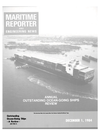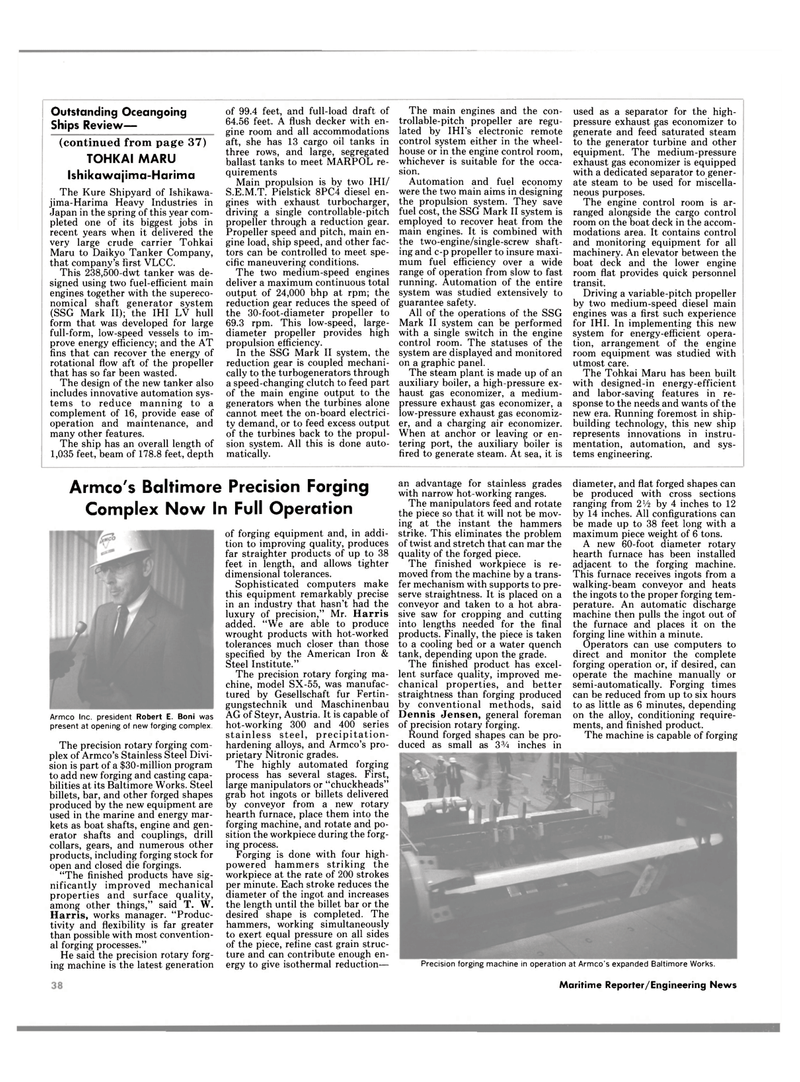
Page 38: of Maritime Reporter Magazine (December 1984)
Read this page in Pdf, Flash or Html5 edition of December 1984 Maritime Reporter Magazine
Outstanding Oceangoing
Ships Review— (continued from page 37)
TOHKAI MARU
Ishikawajima-Harima
The Kure Shipyard of Ishikawa- jima-Harima Heavy Industries in
Japan in the spring of this year com- pleted one of its biggest jobs in recent years when it delivered the very large crude carrier Tohkai
Maru to Daikyo Tanker Company, that company's first VLCC.
This 238,500-dwt tanker was de- signed using two fuel-efficient main engines together with the supereco- nomical shaft generator system (SSG Mark II); the IHI LV hull form that was developed for large full-form, low-speed vessels to im- prove energy efficiency; and the AT fins that can recover the energy of rotational flow aft of the propeller that has so far been wasted.
The design of the new tanker also includes innovative automation sys- tems to reduce manning to a complement of 16, provide ease of operation and maintenance, and many other features.
The ship has an overall length of 1,035 feet, beam of 178.8 feet, depth of 99.4 feet, and full-load draft of 64.56 feet. A flush decker with en- gine room and all accommodations aft, she has 13 cargo oil tanks in three rows, and large, segregated ballast tanks to meet MARPOL re- quirements
Main propulsion is by two IHI/
S.E.M.T. Pielstick 8PC4 diesel en- gines with exhaust turbocharger, driving a single controllable-pitch propeller through a reduction gear.
Propeller speed and pitch, main en- gine load, ship speed, and other fac- tors can be controlled to meet spe- cific maneuvering conditions.
The two medium-speed engines deliver a maximum continuous total output of 24,000 bhp at rpm; the reduction gear reduces the speed of the 30-foot-diameter propeller to 69.3 rpm. This low-speed, large- diameter propeller provides high propulsion efficiency.
In the SSG Mark II system, the reduction gear is coupled mechani- cally to the turbogenerators through a speed-changing clutch to feed part of the main engine output to the generators when the turbines alone cannot meet the on-board electrici- ty demand, or to feed excess output of the turbines back to the propul- sion system. All this is done auto- matically.
The main engines and the con- trollable-pitch propeller are regu- lated by IHI's electronic remote control system either in the wheel- house or in the engine control room, whichever is suitable for the occa- sion.
Automation and fuel economy were the two main aims in designing the propulsion system. They save fuel cost, the SSG Mark II system is employed to recover heat from the main engines. It is combined with the two-engine/single-screw shaft- ing and c-p propeller to insure maxi- mum fuel efficiency over a wide range of operation from slow to fast running. Automation of the entire system was studied extensively to guarantee safety.
All of the operations of the SSG
Mark II system can be performed with a single switch in the engine control room. The statuses of the system are displayed and monitored on a graphic panel.
The steam plant is made up of an auxiliary boiler, a high-pressure ex- haust gas economizer, a medium- pressure exhaust gas economizer, a low-pressure exhaust gas economiz- er, and a charging air economizer.
When at anchor or leaving or en- tering port, the auxiliary boiler is fired to generate steam. At sea, it is used as a separator for the high- pressure exhaust gas economizer to generate and feed saturated steam to the generator turbine and other equipment. The medium-pressure exhaust gas economizer is equipped with a dedicated separator to gener- ate steam to be used for miscella- neous purposes.
The engine control room is ar- ranged alongside the cargo control room on the boat deck in the accom- modations area. It contains control and monitoring equipment for all machinery. An elevator between the boat deck and the lower engine room flat provides quick personnel transit.
Driving a variable-pitch propeller by two medium-speed diesel main engines was a first such experience for IHI. In implementing this new system for energy-efficient opera- tion, arrangement of the engine room equipment was studied with utmost care.
The Tohkai Maru has been built with designed-in energy-efficient and labor-saving features in re- sponse to the needs and wants of the new era. Running foremost in ship- building technology, this new ship represents innovations in instru- mentation, automation, and sys- tems engineering.
Armco's Baltimore Precision Forging
Complex Now In Full Operation an advantage for stainless grades with narrow hot-working ranges.
The manipulators feed and rotate the piece so that it will not be mov- ing at the instant the hammers strike. This eliminates the problem of twist and stretch that can mar the quality of the forged piece.
The finished workpiece is re- moved from the machine by a trans- fer mechanism with supports to pre- serve straightness. It is placed on a conveyor and taken to a hot abra- sive saw for cropping and cutting into lengths needed for the final products. Finally, the piece is taken to a cooling bed or a water quench tank, depending upon the grade.
The finished product has excel- lent surface quality, improved me- chanical properties, and better straightness than forging produced by conventional methods, said
Dennis Jensen, general foreman of precision rotary forging.
Round forged shapes can be pro- duced as small as 3% inches in diameter, and flat forged shapes can be produced with cross sections ranging from 2Vi by 4 inches to 12 by 14 inches. All configurations can be made up to 38 feet long with a maximum piece weight of 6 tons.
A new 60-foot diameter rotary hearth furnace has been installed adjacent to the forging machine.
This furnace receives ingots from a walking-beam conveyor and heats the ingots to the proper forging tem- perature. An automatic discharge machine then pulls the ingot out of the furnace and places it on the forging line within a minute.
Operators can use computers to direct and monitor the complete forging operation or, if desired, can operate the machine manually or semi-automatically. Forging times can be reduced from up to six hours to as little as 6 minutes, depending on the alloy, conditioning require- ments, and finished product.
The machine is capable of forging
Precision forging machine in operation at Armco's expanded Baltimore Works.
Maritime Reporter/Engineering News
Armco Inc. president Robert E. Boni was present at opening of new forging complex.
The precision rotary forging com- plex of Armco's Stainless Steel Divi- sion is part of a $30-million program to add new forging and casting capa- bilities at its Baltimore Works. Steel billets, bar, and other forged shapes produced by the new equipment are used in the marine and energy mar- kets as boat shafts, engine and gen- erator shafts and couplings, drill collars, gears, and numerous other products, including forging stock for open and closed die forgings. "The finished products have sig- nificantly improved mechanical properties and surface quality, among other things," said T. W.
Harris, works manager. "Produc- tivity and flexibility is far greater than possible with most convention- al forging processes."
He said the precision rotary forg- ing machine is the latest generation 40 of forging equipment and, in addi- tion to improving quality, produces far straighter products of up to 38 feet in length, and allows tighter dimensional tolerances.
Sophisticated computers make this equipment remarkably precise in an industry that hasn't had the luxury of precision," Mr. Harris added. "We are able to produce wrought products with hot-worked tolerances much closer than those specified by the American Iron &
Steel Institute."
The precision rotary forging ma- chine, model SX-55, was manufac- tured by Gesellschaft fur Fertin- gungstechnik und Maschinenbau
AG of Steyr, Austria. It is capable of hot-working 300 and 400 series stainless steel, precipitation- hardening alloys, and Armco's pro- prietary Nitronic grades.
The highly automated forging process has several stages. First, large manipulators or "chuckheads" grab hot ingots or billets delivered by conveyor from a new rotary hearth furnace, place them into the forging machine, and rotate and po- sition the workpiece during the forg- ing process.
Forging is done with four high- powered hammers striking the workpiece at the rate of 200 strokes per minute. Each stroke reduces the diameter of the ingot and increases the length until the billet bar or the desired shape is completed. The hammers, working simultaneously to exert equal pressure on all sides of the piece, refine cast grain struc- ture and can contribute enough en- ergy to give isothermal reduction—

 37
37

 39
39
